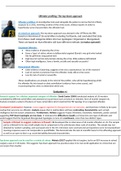Offender profiling: The top-down approach
Offender profiling: An investigative tool used alongside the police to narrow the list of likely
suspects to a crime, involving scrutiny of the crime scene, witness reports In order to
hypothesise some characteristics the offender had.
An American approach: The top down approach was devised in the 1970s by the FBI,
based on interviews of 36 serial killers including Ted Bundy, and concluded that data
from these could categories killers into two typologies= Organised or disorganised.
These are based on that offenders will have different methods (A modus operandi)
Organised Offender:
Show evidence of planning the crime.
Have a ‘type’ of victim, whom is deliberately targeted (Bundy’s was girls who looked
like his girlfriend, long parted hair)
High level of control and precision during the crime, little evidence left behind
Often high intelligence, have a family, socially and sexually successful
Disorganised Offender:
Little evidence of planning, suggests crime was a spontaneous ‘act of the moment’
Lack of control or precision from the offender, body still at crime scene
Low IQ, lack of social or sexual life.
These classifications are already in the mind of the profiler, who will be hypothesising which
the offender fits into based on data assimilation (evidence from crime scene), and
reconstructing the crime, to determine which one.
Evaluation +/-
Research support for a distinct organised category of offender: David Canter (2004) conducted analysis of US murders
committed by different serial killers and assessed co-occurrences such as torture or restraint, form of murder weapon etc.
Analysis revealed a subset of features of many serial killers which matched the FBI typology of an organised offender.
Developed Counterpoint: However, many suggest organised & disorganised are not exclusive, and that there is likely to be some
overlap that occurs by an offender. Godwin argues that in reality killers will have contrasting characteristics such as high
intelligence but low sexual competence. Furthermore, Holmes suggests 4 types (Visionary, missionary, hedonistic, power control)
suggesting TOP down typologies are too basic, it reiterates the difficulty to classify a criminal into one type of offender and
would suggest that the Organised-Disorganised typologies is more of a continuum, more than two distinct types.
Sample criticised to suggest evidence is flawed: FBI developed this on interviews of 36 murder offenders in US. The sample
can be criticised for its very small sample size in comparison to the unfortunate sheer scale of murders. The sample was not
obtained by random sampling, and was based only in the US. Interviews were unstructured and questions were not standardised
meaning responses were not comparable or quantifiable. This demonstrates the lack of scientific basis for this offending approach
as well as an open to bias’s e.g. social desirability/demand characteristics.
Top-down approach can be used for a variety of crimes: Meketa (2017) applied this to burglary, led to an 85% increase in solved
burglary cases in 3 US states. This suggests Top down approach has practical value in its real world application to crimes that are
less severe than murder.





